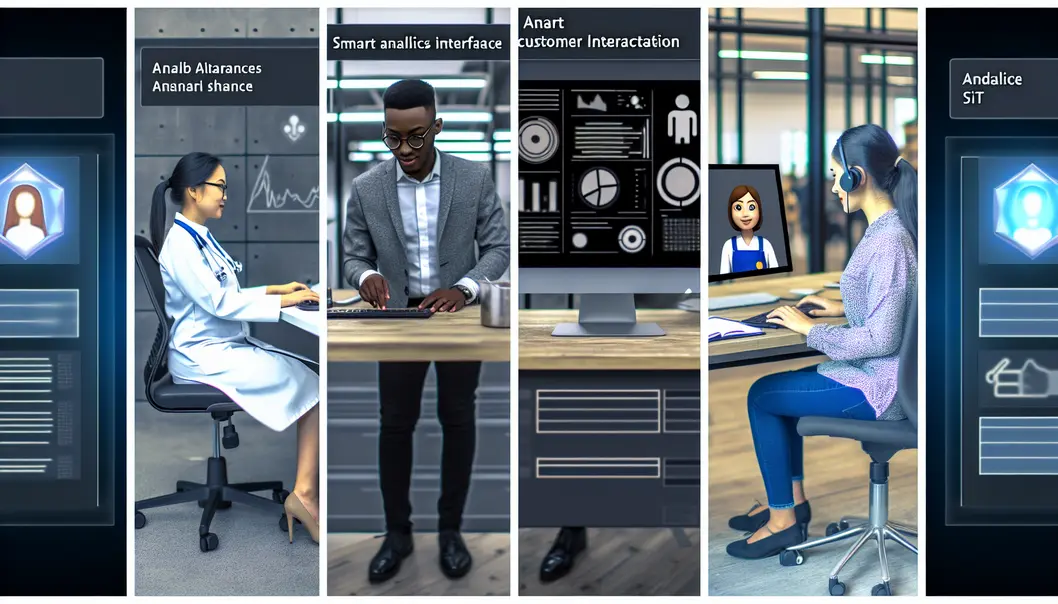
AI agents are reshaping various domains by automating tasks and offering solutions that were once considered complex and time-consuming. These intelligent entities use specialized algorithms to perform tasks, learn from data, and make decisions. Their applications span from simple personal assistants to complex data analysis systems, impacting everyday life and business operations alike. This article delves into the concept of AI agents, their diverse applications, and guidance on training them, making sophisticated technology accessible to everyone.
Understanding AI Agents: Definitions and Capabilities

Artificial Intelligence (AI) agents have emerged as the quintessential tool in today’s technological landscape, redefining how various tasks and operations are undertaken across industries. At a fundamental level, an AI agent is an autonomous entity that perceives its environment through sensors and acts upon that environment using actuators based on the data it gathers. Its primary purpose is to perform tasks that would otherwise require human intelligence, often delivering results with enhanced efficiency and precision.
The intrinsic features of AI agents encompass a range of functionalities driven by their ability to learn and adapt from experience, a hallmark property underscored by machine learning. Additionally, these agents excel in understanding and processing human language through natural language processing (NLP), thus enhancing their interaction with users in more intuitive ways. Neural networks, a subset of machine learning, underpin many AI agents by mimicking the human brain’s interconnected neurons, allowing for advanced problem-solving capabilities.
In healthcare, AI agents are pioneering advances in both diagnostic and administrative functions. Consider a scenario where a medical imaging AI agent aids radiologists by analyzing X-ray images to identify early stages of diseases like cancer, often with a level of accuracy and speed unattainable by human examiners alone. Such agents use vast datasets and deep learning algorithms to discern patterns and anomalies. Meanwhile, in administrative capacities, they streamline patient scheduling, enhancing operational efficiency and allowing healthcare providers to focus on patient care.
The finance industry also sees transformative impacts from AI agents. For instance, automated trading systems operate with AI agents that execute trades based on predictive market analyses, responding to market conditions in real-time. These agents utilize complex algorithms to predict stock movements and make decisions at speeds unmatched by human brokers. Additionally, customer service agents in banks use NLP to interpret customer inquiries, providing tailored solutions and managing transactions securely, around the clock.
In the customer service realm, AI agents come in the form of chatbots and virtual assistants. Aided by advancements in natural language processing and machine learning, these agents handle routine inquiries and support issues, providing quick resolutions while maintaining a semblance of human-like interaction. Through continual learning from past interactions, they fine-tune their responses, thereby improving service quality over time.
Different types of AI agents are categorized primarily by their operational framework and complexity: reactive agents, proactive agents, and hybrid agents. Reactive agents respond to immediate environmental stimuli without considering past states. Proactive agents, equipped with strategic planning capabilities, anticipate future scenarios and take preemptive actions. Hybrid agents integrate both reactive and proactive elements, balancing real-time responses with long-term strategic goals.
The success of AI agents across these domains is powered by underlying technologies, notably machine learning models that facilitate learning from data and improving upon past performances. For example, this blog on encouraging children to be obedient draws parallels to AI’s potential for customized learning paths, demonstrating adaptive behavior similar to personalized learning systems employed by AI agents.
Neural networks further equip AI agents with the capacity for recognizing patterns and making predictions. Networks with many layers, known as deep neural networks, process complex datasets to perform tasks such as image and speech recognition with higher accuracy. Natural language processing empowers these agents to comprehend and generate human language, making them vital in applications ranging from voice-activated assistants to language translation services.
In summary, AI agents are not merely tools; they are versatile collaborators across industries, augmenting human effort by leveraging data-driven intelligence. As they continue to evolve, their role in transforming everyday interactions and processes becomes even more pronounced, signaling an era where AI’s intricate workings are seamlessly embedded within the fabric of daily life.
Applications of AI Agents in Everyday Life

The integration of AI agents into everyday activities has become an undeniable reality, enhancing the rhythm of daily routines by boosting efficiency and tailoring experiences to individual needs. These agents, embedded in smart home systems, virtual assistants, and personal productivity applications, redefine how we interact with technology, making life more convenient and personalized.
In residential settings, AI agents serve as the backbone of smart home systems. They manage lighting, climate, and security with precision, adapting to user habits and preferences. Through continuous learning, these systems predict the most desirable room temperatures or preferred lighting conditions, offering seamless automation. Sensor data and user feedback are leveraged to refine operations, ensuring they actively contribute to energy conservation and household management efficiency.
Virtual assistants are another pivotal application of AI agents that showcase their evolving capabilities. These agents conduct tasks ranging from managing calendars to setting reminders and answering complex queries. The sophistication of natural language processing engines has made interactions with virtual assistants increasingly fluid, enabling them to understand and respond to human language with near-human accuracy. This ease of use transforms them from mere tools into trusted digital companions, capable of conducting real-time translations or even serving as intermediaries for making online purchases.
Personal productivity apps are yet another domain where AI agents exert a considerable influence. These applications analyze user habits to optimize time management and task prioritization, enhancing overall productivity. By learning from users’ work patterns, these agents propose targeted suggestions, like identifying the best time for focus-intensive activities or organizing meeting schedules more effectively. Similarly, email and notification management is fine-tuned to eliminate distractions, allowing users to concentrate on significant tasks.
AI agents also personalize entertainment by curating content based on user preferences and past consumption patterns. Streaming services advocate recommendations for movies, music, or podcasts by learning from user behavior, creating bespoke entertainment experiences. Moreover, AI-driven content synopsis and summarization alleviate decision fatigue by providing users with concise reviews and previews.
In the realm of fitness and wellness, AI agents offer personalized coaching and health monitoring. These applications track exercise routines, nutritional intake, and sleep patterns to generate insights and recommendations tailored to individual fitness goals. They also facilitate mental well-being through mindfulness and stress-relief exercises, delivered at optimal times based on user mood and stress levels.
Education is another sector reaping benefits from AI agents. Virtual tutors and learning platforms adjust to students’ learning speeds and styles, offering curated resources and feedback. By identifying knowledge gaps, they create customized learning pathways, encouraging lifelong learning through interactive and engaging methodologies.
Consumer electronics and personal devices are at the forefront of integrating AI agents to create smart ecosystems. These technologies enable connectivity between devices, enabling them to communicate and cooperate for enhanced user experiences. For example, people’s devices can synchronize seamlessly to share information, control home environments, or navigate between work screens and personal media seamlessly.
The pervasive integration of AI agents in everyday life signifies not just a shift towards convenience, but a profound transformation of interactions with technology. The future will likely see these agents becoming increasingly ingrained in personal and professional spheres, continuing to evolve in response to user needs and technological advancements.
For parents and caregivers interested in exploring further applications of AI in childhood development and educational technology, the article on tips to help nurture children’s smart play offers valuable insights.
Training AI Agents: A User-Friendly Approach

Training AI agents may sound daunting, especially for those new to artificial intelligence. Yet, it’s more accessible than it seems, thanks to user-friendly platforms designed for beginners. These tools simplify the process, allowing anyone to contribute to the advancement of AI technologies. This chapter will guide you through training AI agents using simple data inputs, with step-by-step instructions on data preparation, algorithm application, and performance evaluation.
To begin training an AI agent, the first step is data preparation. This involves collecting data relevant to the specific task you want your AI agent to perform. For instance, if you aim to train an AI to recognize images of cats and dogs, you’ll need a dataset containing various labeled images of these animals. Data should be comprehensive and diverse to ensure the agent learns effectively across different scenarios. Collecting this data can be as simple as using a camera or sourced from open databases available online.
Once your data is ready, the next step is refining it. This involves cleaning the data, which means removing any errors or inconsistencies. Ensuring your dataset is accurate and well-structured is crucial for the success of the training process. Organize your data into categories and label it appropriately to provide clarity for the AI. This structured data serves as the foundation upon which the AI builds its understanding.
With your data organized, you can now choose a platform or tool to train your AI agent. Several user-friendly platforms cater to beginners, offering intuitive interfaces that simplify the machine-learning process. These platforms often provide guided tutorials and built-in algorithms that allow you to apply machine learning techniques without needing to write complex code.
The core step involves selecting an appropriate algorithm for your specific needs. Some platforms feature automated selection processes, recommending the most suitable algorithm based on your data type and intended use. You might choose a decision tree for simple classification tasks, or a more complex neural network if your data involves images or natural language processing. These algorithms rely on the input data to establish patterns, learning iteratively through several experiences.
During the training phase, your chosen algorithm processes the data, adjusting its internal parameters to reduce error rates. This is often done through a method called supervised learning, where the agent examines labeled examples to understand input-output relationships. As the model processes more data, it becomes increasingly adept at performing the intended task, albeit with periodic evaluations.
Once the training is complete, evaluating your AI agent’s performance is essential. Evaluation involves feeding a separate set of data, not used during the training phase, to the AI to assess its accuracy and efficiency. This is known as the testing phase, where metrics such as precision, recall, and F1 score help gauge the agent’s proficiency. A high-performance level indicates that the algorithm has successfully understood the patterns in the data.
Throughout this process, remember that continuous refinement is key. Regularly updating your data and retraining the model, as new data becomes available or as task requirements evolve, ensures the AI agent remains relevant and efficient. This iterative process is crucial for maintaining a robust AI agent.
Understanding the potential pitfalls during training is equally important. Overfitting, for instance, occurs when an AI model learns the training data too well, including the noise, rendering it less effective with new data. Balancing between bias and variance prevents the AI from becoming too rigid or too reliant on the training data alone.
By leveraging these user-friendly tools and following these structured steps, training AI agents becomes an attainable task for non-experts. This not only fosters innovation but also encourages a broader audience to partake in AI development. As these technologies become more integrated into our daily lives, understanding and participating in their training enhances how effectively they serve us, with applications ranging from smart home systems to virtual assistants.
Through this hands-on approach, the barrier to entering AI training is lowered, paving the way for more inclusive and versatile AI agent applications in everyday life. For parents interested in nurturing innovation and creativity in their children’s learning process, engaging in such activities can also foster foundational skills in technology and problem-solving Bộ Chơi Cùng Con Giúp Con Thông Minh Hơn.
Overcoming Challenges and Ethical Considerations

As AI agents become increasingly integrated into our daily lives, their development and deployment present significant challenges and ethical issues that must be addressed. A primary concern in training AI agents is data privacy. AI systems rely heavily on vast amounts of data to learn and make decisions. However, this dependency raises questions about how data is collected, stored, and used, often without explicit user consent. This can lead to unauthorized access and misuse of personal information. Protecting user data should be of utmost importance, and developers must ensure robust security measures are in place to safeguard against data breaches.
Algorithmic bias presents another formidable challenge. When AI systems are trained on biased data sets, they can produce skewed outcomes that perpetuate or even exacerbate existing biases. For example, if an AI agent is trained predominantly on data representing one demographic, it might not adequately serve or may unfairly disadvantage other groups. Identifying and mitigating bias requires diverse and representative data sets along with continuous monitoring and adjustment of AI models.
Moreover, AI developers must contend with the ethical implications of their creations. The deployment of AI tools turns the spotlight on issues such as accountability and transparency. Who is responsible when an AI system makes a mistake? Ensuring clarity in AI decision-making processes is crucial, fostering trust and allowing users to understand and verify AI-generated conclusions. Transparency extends to providing explanations of how an AI agent functions, enabling users to recognize inherent limitations and make informed decisions.
To mitigate these challenges, developers should adhere to best practices that encompass both technological and ethical considerations. Firstly, implementing data minimization—collecting only as much data as necessary—can significantly reduce privacy risks. Alongside this, employing robust encryption standards ensures that data remains secure.
Addressing algorithmic bias requires a multi-faceted approach. One effective strategy is to establish diverse teams working in AI development. Diverse perspectives help identify potential areas of bias that might not be immediately apparent. Additionally, AI models should be evaluated against a wide array of scenarios to detect and correct biases before deployment.
Ethical AI must also have mechanisms for appeal and redress. If a user disputes an AI decision, there should be simple pathways to challenge and rectify incorrect or unfair outcomes. Moreover, engaging with stakeholders, including those who interact with AI systems, can provide valuable insights into potential ethical concerns, fostering a more ethically robust AI landscape.
Finally, fostering a culture of continued education and awareness about AI’s ethical dimensions is essential. Developers, policymakers, and AI users should have a clear understanding of the societal impacts of AI, enabling them to navigate ethical dilemmas more effectively. This can include regular workshops and the creation of advisory committees dedicated to evaluating the societal implications of AI technologies.
By addressing these challenges head-on, AI developers and stakeholders can develop agents that not only deliver on their potential but do so in a responsible and equitable manner. As AI continues to evolve, the commitment to ethical practices and the overcoming of technical challenges will be crucial in ensuring that AI technologies truly benefit society. For further insights, you might explore how nurturing intelligence and creativity can positively influence AI development, as discussed in resources dedicated to boosting human potential, such as this guide.
Final words
AI agents continue to revolutionize various industries and daily life by offering intelligent solutions to complex problems. By understanding and training these agents, individuals and businesses can harness their potential for greater efficiency and personalization. As we embrace these technologies, ethical and responsible use becomes paramount, ensuring a balance between innovation and societal values.
Stay informed and explore how you can integrate AI agents into your life. Share your thoughts and experience at Helokidz!
Learn more: https://helokidz.com/
About us
Helokidz – “Nét chữ nết người”. Our platform shares valuable experiences and knowledge about parenting and child-rearing for parents.



